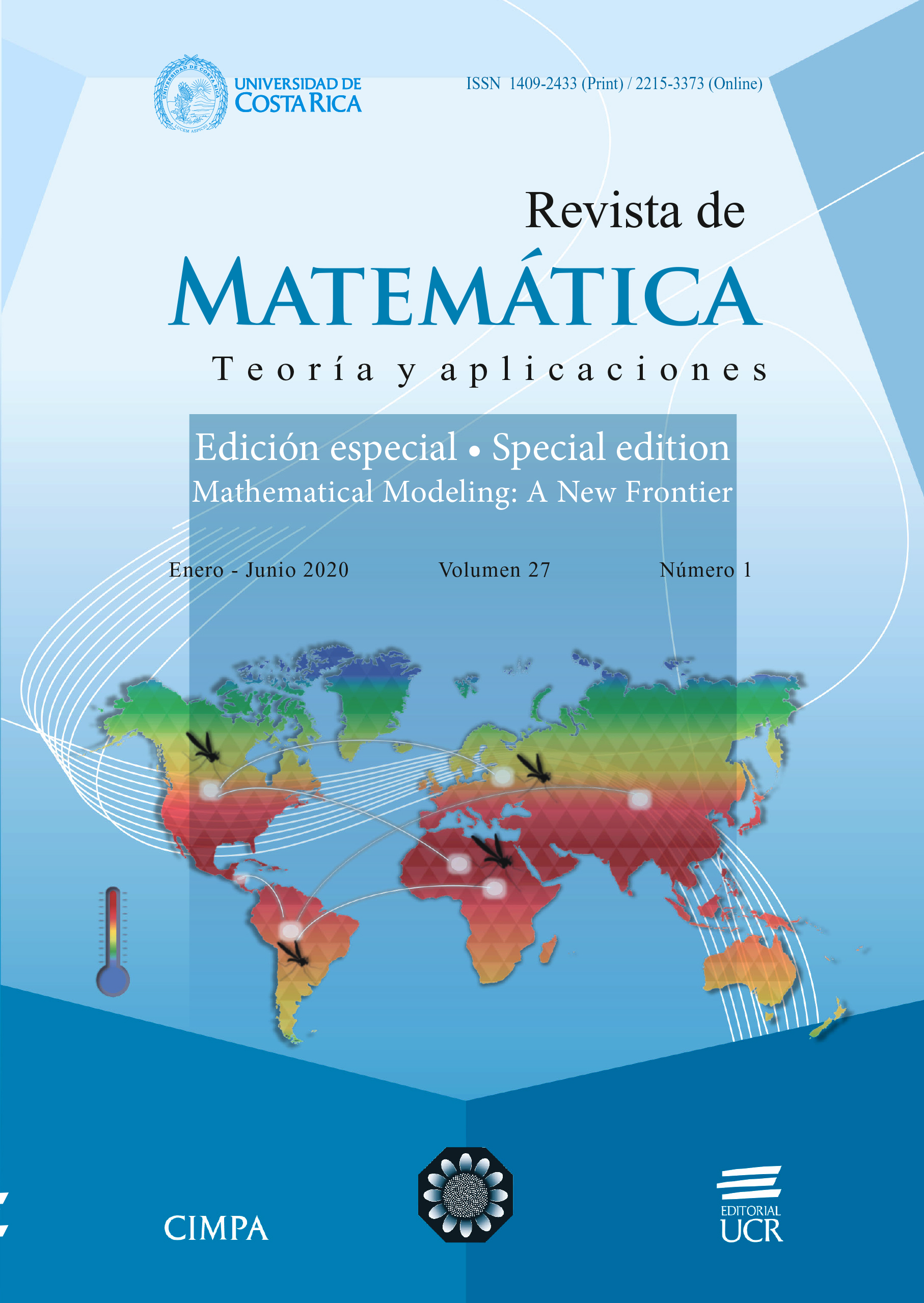Resumen
La propagación de enfermedades infecciosas y su impacto en individuos juega un gran rol en la dinámica de enfermedades, y es importante incorporar heterogeneidad en la población en los esfuerzos por estudiar enfermedades. De manera simplística pero ilustrativa, se examinan interacciones entre una población urbana y una rural en la dinámica de la propagación de una enfermedad. Utilizando un sistema compartimental de dinámicas entre susceptibles–infectados–susceptibles (SIS) con cierto nivel de inmunidad, se formula un modelo que permite reinfecciones no lineales. Se investiga los efectos de movimiento de poblaciones en un escenario simple: un caso con dos poblaciones, que permite modelar movimiento entre un área urbana y otra rural. Con el fin de estudiar la dinámica del sistema, se calcula el número básico reproductivo para cada comunidad (rural y urbana). Se calculan también puntos de equilibrio, la estabilidad local del estado libre de enfermedad, y se identifican condiciones para la existencia de estados de equilibrio endémicos. Del análisis y experimentos computacionales, se ilustra que el movimiento en la población juega un rol importante en la dinámica del sistema. En algunos casos, puede ser beneficioso, pues incrementa la región de estabilidad del punto de equilibrio del estado libre de infección.
Citas
L. Alvarado, Costa Rica once again under malaria alert, The Costa Rica Star, 2018. Available at https://news.co.cr/ costa-rica-once-again-under-malaria-alert/73681, accessed 25/04/2019.
D. Bichara, C. Castillo-Chavez, Vector-borne diseases models with residence times — A Lagrangian perspective, Math. Biosci. 281(2016), 128–138. doi: 10.1016/j.mbs.2016.09.006
F. Brauer, C. Castillo-Chavez, Mathematical Models in Population Biology and Epidemiology, 2nd edition, Springer-Verlag, Providence RI, USA, 2012.
Center for Disease Control and Prevention, Severe acute respiratory system (SARS), 2019. Available at https://www.cdc.gov/sars/index. html
Center for Disease Control and Prevention, Ebola (Ebola virus disease), 2019. Available at https://www.cdc.gov/vhf/ebola/ history/2014-2016-outbreak/index.html
Center for Disease Control and Prevention, Measles (Rubeola), 2019. Available at https://www.cdc.gov/measles/index.html
G. Chowell, P.W. Fenimore, M.A. Castillo-Garsow C. Castillo-Chavez, SARS outbreaks in Ontario, Hong Kong and Singapore: The role of diagnosis and isolation as a control mechanism, J. Theor. Biol. 224(2003), no. 1, 1–8. doi: 10.1016/S0022-5193(03)00228-5
M.P. Coffee, G.P. Garnett, M. Mlilo, H.A.C.M. Voeten, S. Chandiwana, S. Gregson, Patterns of movement and risk of HIV Infection in rural Zimbabwe, J. Infect. Dis. 191(2005), no. 1, S159–S167. doi: 10.1086/ 425270
J.M. Crutcher, S.L. Hoffman, Malaria, in: S. Baron (Ed.) Medical Microbiology, 4th edition, University of Texas Medical Branch at Galveston, Galveston TX, 1996, ch. 83. Available in: https://www.ncbi.nlm. nih.gov/books/NBK8584/
R. DeVore, A. Ron, Approximation of functions, Proc. Sympos. Appl. Math.36(1986), 34–56.
Z. Feng, J. X. Velasco-Hernández, Competitive exclusion in a vector–host model for the dengue fever, J. Math. Biol. 35(1997), no. 5, 523–544. doi: 10.1007/s002850050064
Z. Feng, C. Castillo-Chavez, A. F. Capurro, A model for tuberculosis with exogenous reinfection, Theor. Popul. Biol. 57(2000), no. 3, 235–247. doi: 10.1006/tpbi.2000.1451
H. Frankowska, The Poincaré–Miranda theorem and viability condition, J. Math. Anal. Appl. 463(2018), no. 2, 832–837. doi: 10.1016/j.jmaa. 2018.03.047
J. Gjorgjieva, K. Smith, G. Chowell, F. Sanchez, J. Snyder, C. CastilloChavez, The role of vaccination in the control of SARS, Math. Biosci. Eng. 2(2005), no. 4, 753–769. doi: 10.1006/tpbi.2000.1451
J.R. Glynn, J. Murray, A. Bester, G. Nelson, S. Shearer, P. Sonnenberg, Effects of duration of HIV infection and secondary tuberculosis transmission on tuberculosis incidence in the South African gold mines, AIDS 22(2008), no. 14, 1859–1867. doi: 10.1097/QAD.0b013e3283097cfa.
J.L. Grun, W.P. Weidanz, Antibody-independent immunity to reinfection malaria in B-cell-deficientmice, Infect. and Immun. 41(1983),no.3,1197– 1204.
W. Kulpa, The Poincaré–Miranda theorem, Amer. Math. Month. 104(1997), no. 6, 545–550. doi: 10.2307/2975081
S.Lee,C.Castillo-Chavez,The role of residence times in two-patch dengue transmission dynamics and optimal strategies, J. Theor. Biol. 374(2015), no. 7, 152–164. doi: 10.1016/j.jtbi.2015.03.005
C.A. Manore, K.S. Hickmann, S. Xu, H.J. Wearing, J.M. Hyman, Comparing dengue and chikungunya emergence and endemic transmission in A. aegypti and A. albopictus, J. Theor. Biol. 356(2014), 174–191. doi: 10.1016/j.jtbi.2014.04.033
P. Martens, L. Hall, Malaria on the move: Human population movement and malaria transmission, Emerg. Infect. Diseas.6(2000), no. 2, 103–109. doi: 10.3201/eid0602.000202
D. Murillo, S. Holechek, A. Murillo, F. Sanchez, C. Castillo-Chavez, Vertical transmission in a two-strain model of dengue fever, Lett. Biomath. 1(2014),no.2,249–271.doi: 10.1080/23737867.2014.11414484
R. Pastor-Satorras, C. Castellano, P. van Mieghem, A. Vespignani, Epidemic processes in complex networks, Rev. Mod. Phys. 87(2015), no. 3, 925–979.
F. Sanchez, M. Engman, L.C. Harrington, C. Castillo-Chavez, Models for dengue transmission and control, in: A.B. Gumel, C. Castillo-Chavez, R.E. Mickens & D.P. Clemence (Eds.) Mathematical Studies on Human Disease Dynamics. Emerging Paradigms and Challenges, Contemp. Math. 410, Amer. Math. Soc., Providence RI, USA, 2006, pp. 311–326. doi: 10.1090/conm/410/07734
F. Sanchez, X. Wang, C. Castillo-Chavez, D. Gorman, P.J. Gruenewald, Drinking as an epidemic — A simple mathematical model with recovery and relapse, in: K.A. Witkiewitz & G.A. Marlatt (Eds.) Therapist’s Guide to Evidence-Based Relapse Prevention, Academic Press, Cambridge, MA, USA, 2007, pp. 353–368. doi: 10.1016/B978-012369429-4/ 50046-X
F. Sanchez, D. Murillo, C. Castillo-Chavez, Change in host behavior and its impact on the transmission dynamics of dengue, in: R.P. Mondaini (Ed.) International Symposium on Mathematical and Computational Biology, BIOMAT 2011 (Santiago, Chile), 2012, pp. 191–203. doi: https: //doi.org/10.1142/9789814397711_0013
F. Sanchez, J. G. Calvo, E. Segura, Z. Feng, A partial differential equation model with age-structure and nonlinear recidivism: Conditions for a backward bifurcation and a general numerical implementation, Computers and Mathematics with Applications 78(2018), no. 12, 3916–3930. doi: url10.1016/j.camwa.2019.06.021
B. Song, M. Castillo-Garsow, K.R. Rios-Soto, M. Mejran, L. Henso, C. Castillo-Chavez, Raves, clubs and ecstasy: The impact of peer pressure, Math.Biosci.Eng.3(2006),no.1,249–266.doi: 10.3934/mbe.2006. 3.249
B. Song, W. Du, J. Lou, Different types of backward bifurcations due to density-dependent treatments, Math. Biosci. Eng. 10(2013), no. 5–6, 1651–1668. doi: 10.3934/mbe.2013.10.1651
K. Szyma´nska-De¸bowska, On a generalization of the Miranda Theorem and its application to boundary value problems, J. Diff. Equ. 258(2015), no. 8, 2686–2700. doi: 10.1016/j.jde.2014.12.022
A.J. Treno, P.J. Gruenewald, L.G. Remer, F. Johnson, E.A. LaScala, Examining multi-level relationships between bars, hostility and aggression: Social selection and social influence, Addiction 103(2007), no. 1, 66–77. doi: 10.1111/j.1360-0443.2007.02039.x
M.Turzánski, The Bolzano–Poicaré–Mirandatheorem—Discreteversion, Topol. Appl. 159(2012), no. 13, 3130–3135. doi: 10.1016/j.topol. 2012.05.026

